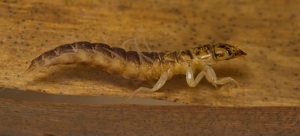Classification

Domain: Eukarya
Kingdom: Animilia
Phylum: Arthropoda
Class: Insecta
Order: Megaloptera
Family: Sialidae
Genus: Sialis
Species: Sialis velata
Genus and Species: Sialis velata consists of the genus and species name which was first discovered by Herbert Holdsworth Ross in 1937 (Discover Life). Species within the genus Sialis can be determined by looking closely at their genitalia. The male Sialis velata can be distinguished by their long genital arms that curve at a 90 degree angle attaching to the genital plate. The terminal plate has a quadrate shape and slightly cleft (Whiting 1991). Sialis velata also possesses a sub-genital plate with a shallow longitudinal indentation (Engel 2004).
Family: The family Sialidae are characterized by the larvae having an elongated abdomen, a terminal filament, lacking a pair of apical prolegs, and seven pairs of lateral gill filaments (Engel 2004). In the adults, Sialidae lack ocelli (Arnett 1985). Adults range from 0.5 to 0.75 inches long, are brown or black in color, and have two pairs of wings (Anderson et al. 2003).


Order: Megaloptera are known for having the largest aquatic insect larvae from the class Insecta (EcoSpark). The larvae have aquatic with biting mouthparts and a distinct labrum, structure similar to a lip. The hind wings are broad at the base and much larger than the front wings, and the anal region is enlarged compared to other orders (Arnett 1985).

Photography courtesy of Spencer Entomological Collection, Beaty Biodiversity Museum, UBC. Photographs by David Griffiths. Left, lateral view of Sialis velata. Right, dorsal view of Sialis velata.
Alderfly larvae. Photo by Neil Phillips
Class: The class Insecta is different from the other orders by having three pairs of legs and two pairs of wings. The wings connect to the thoracic region of the body. Majority of the species within this class are less than 2.5cm long (Hickman et al. 2009).
Phylum: Species within Phylum Arthropoda have exoskeletons and well developed organ systems. Their exoskeleton forms a cuticle containing proteins, such as chitin, and are segmented organism. One of the main differences in segmentation of arthropods from other phylums is that the segments form tagmata, fused segments that from functional groups for specialized purposes (Hickman et al. 2009).
Kingdom: The kingdom Animilia contains multicellular species that are heterotrophic. This kingdom has cells that lack a cell wall (HyperPhysics).
Domain: The domain Eukarya are distinctive by their cell type which is a nucleus containg cell.
